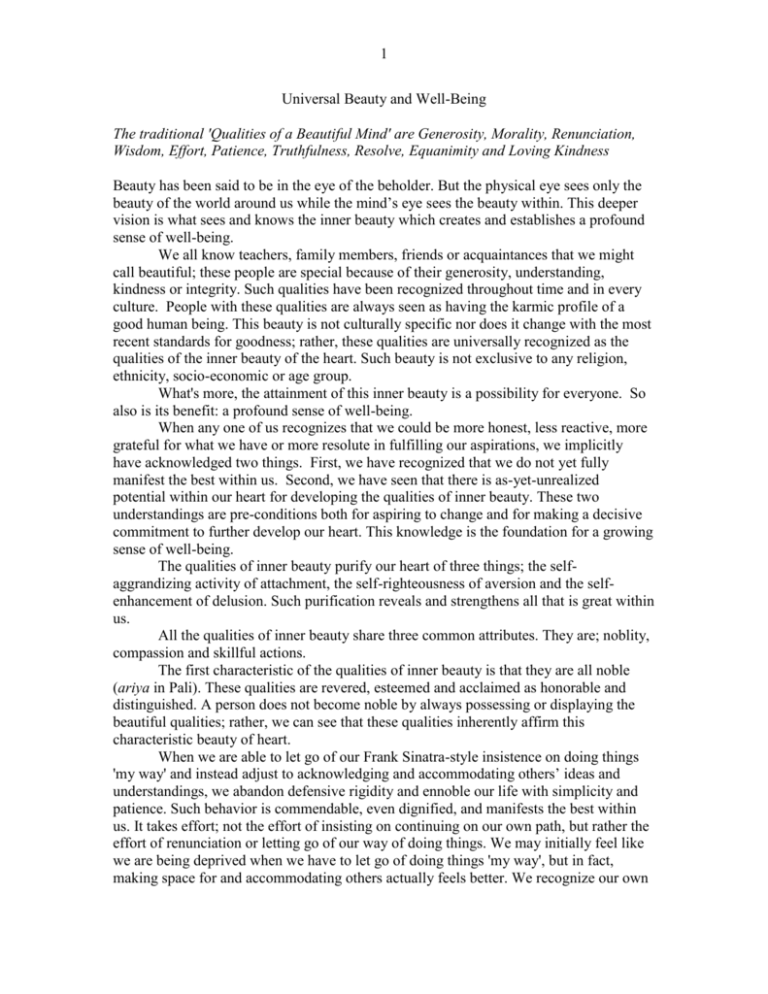Universal Beauty and Well
advertisement

1 Universal Beauty and Well-Being The traditional 'Qualities of a Beautiful Mind' are Generosity, Morality, Renunciation, Wisdom, Effort, Patience, Truthfulness, Resolve, Equanimity and Loving Kindness Beauty has been said to be in the eye of the beholder. But the physical eye sees only the beauty of the world around us while the mind’s eye sees the beauty within. This deeper vision is what sees and knows the inner beauty which creates and establishes a profound sense of well-being. We all know teachers, family members, friends or acquaintances that we might call beautiful; these people are special because of their generosity, understanding, kindness or integrity. Such qualities have been recognized throughout time and in every culture. People with these qualities are always seen as having the karmic profile of a good human being. This beauty is not culturally specific nor does it change with the most recent standards for goodness; rather, these qualities are universally recognized as the qualities of the inner beauty of the heart. Such beauty is not exclusive to any religion, ethnicity, socio-economic or age group. What's more, the attainment of this inner beauty is a possibility for everyone. So also is its benefit: a profound sense of well-being. When any one of us recognizes that we could be more honest, less reactive, more grateful for what we have or more resolute in fulfilling our aspirations, we implicitly have acknowledged two things. First, we have recognized that we do not yet fully manifest the best within us. Second, we have seen that there is as-yet-unrealized potential within our heart for developing the qualities of inner beauty. These two understandings are pre-conditions both for aspiring to change and for making a decisive commitment to further develop our heart. This knowledge is the foundation for a growing sense of well-being. The qualities of inner beauty purify our heart of three things; the selfaggrandizing activity of attachment, the self-righteousness of aversion and the selfenhancement of delusion. Such purification reveals and strengthens all that is great within us. All the qualities of inner beauty share three common attributes. They are; noblity, compassion and skillful actions. The first characteristic of the qualities of inner beauty is that they are all noble (ariya in Pali). These qualities are revered, esteemed and acclaimed as honorable and distinguished. A person does not become noble by always possessing or displaying the beautiful qualities; rather, we can see that these qualities inherently affirm this characteristic beauty of heart. When we are able to let go of our Frank Sinatra-style insistence on doing things 'my way' and instead adjust to acknowledging and accommodating others’ ideas and understandings, we abandon defensive rigidity and ennoble our life with simplicity and patience. Such behavior is commendable, even dignified, and manifests the best within us. It takes effort; not the effort of insisting on continuing on our own path, but rather the effort of renunciation or letting go of our way of doing things. We may initially feel like we are being deprived when we have to let go of doing things 'my way', but in fact, making space for and accommodating others actually feels better. We recognize our own 2 goodness when we think, feel and act in this way. Others appreciate such thoughts and behavior too. Compassion, the second property of inner beauty, makes room for and holds others with care and consideration. When we rest in a non-reactive, balanced strength of mind we make space for others. This humanitarian attitude motivates beneficial actions toward others who are suffering and seeks ways to support wholesome interests everywhere. We all appreciate it when someone sensitively recognizes and acknowledges our situation and responds with a willingness to connect without condemning. When I take the time to connect with the homeless person on the street, I demonstrate my recognition of and interest in them. I’m not sitting in judgment of their behavior or life condition. I’m also not blaming anyone for the conditions I see; nor am I trying to solve the world’s social problems. I am just reaching out to offer the best of human connection: love and acceptance along with support and well-wishing. Not only does the recipient benefit by the love and generosity; I too walk on with a lighter feeling of well-being in my heart. Skillful actions when touching the world is the third trait of universal beauty. The commitment to awaken to the beautiful qualities of heart is accompanied by the willingness to express them. We allow these qualities to manifest in our thoughts, decisions and actions. For example, suppose when I feel hurt or misunderstood, I tend to isolate from others and freeze up. Skillful action would not lie in explaining, cajoling, or criticizing me; that would not melt the ice that has formed over my heart. However, if someone skillfully, patiently and without reacting waits patiently to hear me when I am ready to speak, all will flow again. Many times, the beautiful heart knows that the confident renunciation of doing more is required. It recognizes that the skillful action often lies in doing less. Inner beauty can be more fully developed in each of us. If we simply remember them and raise their profile in our hearts these qualities are more accessible. When we actively cultivate these beautiful qualities of mind, we flourish. We, and others, benefit from an enhanced and enduring sense of well-being. Prepared for Grassroots, the TCVC newsletter by Steve Armstrong Dec 28, 2010








